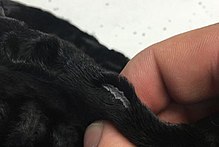Snatch

A Schnatte referred to in the fur trade , the elongated ruptured upper ( epidermis ) of the coat , as incisional hernia described. It is caused by overstretching during processing, either when the fur is removed (peeling off) by the trapper, hunter or breeder, when tanning by the fur dresser or when it is stretched or for purposes by the final processing furrier , especially if the leather has not been sufficiently moisturized beforehand ( "let it fatten").
General
Schnatty skins pose a considerable problem for the middleman. The snakes are often not visible when purchasing the raw skins , or after dressing it can no longer be determined whether the skins were already whackled or whether the dresser did not have the necessary Has worked diligently. In the case of broad-tailed skins, oversized gutters can sometimes result in losses of up to 50 percent of the purchase. Most of the time, the elongated cracks in the upper leather disturb the appearance of the fur garment, and the furrier therefore removes the cords by repairing them when opening them . Snakes can occur sporadically or in larger areas, close together. While larger damage to the fur, in particular cracks, is often repaired by the fur refiner, the repair of the snakes is always the responsibility of the end processor producing the fur .
Some types of fur are easier to snub than others. Are particularly vulnerable, for example, sheepskins , especially the dünnledrigen skins small lambs, especially all kinds of Breitschwanz skins , Persianerfellen , Astrakhan fur , Buenos but also ordinary sheep and lamb skins, as well as occasionally pony skin , calfskin and example, more rarely, the nutria fur .
The term Schnatte occurs in Rotwelsch and means a cut there.
Schnatten repair
The snake, which does not represent a complete tear through the leather, can mostly be recognized from the leather side by a slight irregularity in the structure. When shopping, raw hides are usually held up to the light in order to find out if there is any snub. The principle can also be used with trimmed (tanned) skins with a light box on which the translucent slugs become visible.
If the hair is not too thin and too flat, the snares are cut open with a skinning knife . This can be done either from the hair side or from the leather side, if the snake is sufficiently visible there. The leather edges are in front of the sewing cleaned with scissors of the hairless margins. Then they are closed again, qualitatively best with a hand seam, or faster with the fur sewing machine .
With thin leather with little hairy fur ( Galjak , Russian, Iranian and Afghan wide-tailed tail), the sewn seams would usually result in ugly seams. Here you draw the snakes on the leather after you have previously marked their course from the side of the hair with pins. With flat, hand-sewn stitches that do not fully penetrate the leather, the torn edges are reunited with a short, fine sewing needle in the manner of a butt seam . In the case of thicker skins, a fur machine seam may be sufficient, again without having to cut open the snake beforehand. Some skins occasionally also have larger areas in which many snakes lie together (snatten fields). If it makes economic sense to use these skins as well, these areas are stuffed with fine broadtail skins. With hand seams, the individual laths are also drawn together by flat stitches on the leather side, it is flat stitch by stitch over and next to each other. Especially with thicker skins, larger shaded areas are better replaced.
Heavily shaded sheepskins and lambskins should, if possible, not be used for furs that are to be worn with the leather on the outside (velor, nappalan furs), as any repair would be visible on the outside. The extent to which snares can also be closed with modern, water- and cleaning-resistant adhesives has probably not yet been described in the literature.
Web links
Individual evidence
- ↑ Rudolf Toursel : processing a wide tail coat .
- ^ Information from Mr. Homm, Mayer & Cie., Frankfurt am Main and Zurich, June 11, 2018.
- ↑ a b c d August Dietzsch, Kurt Häse, Paul Schöps: Das Anbrachen . In: Das Pelzgewerbe No. 2, 1956, Verlag Dr. Paul Schöps, pp. 62-63, 65-66.
- ↑ a b Alexander Tuma: Pelz-Lexikon. Fur and Rough Goods, Volume XXI . Alexander Tuma, Vienna 1951, p. 123–124, keyword "Schnatten" .
- ^ Birlinger: Comparative language studies in Alemannic and Swabian (continued) . Last accessed on May 7, 2018.
- ↑ Rudolf Toursel: Bueno lamb coat processing .

